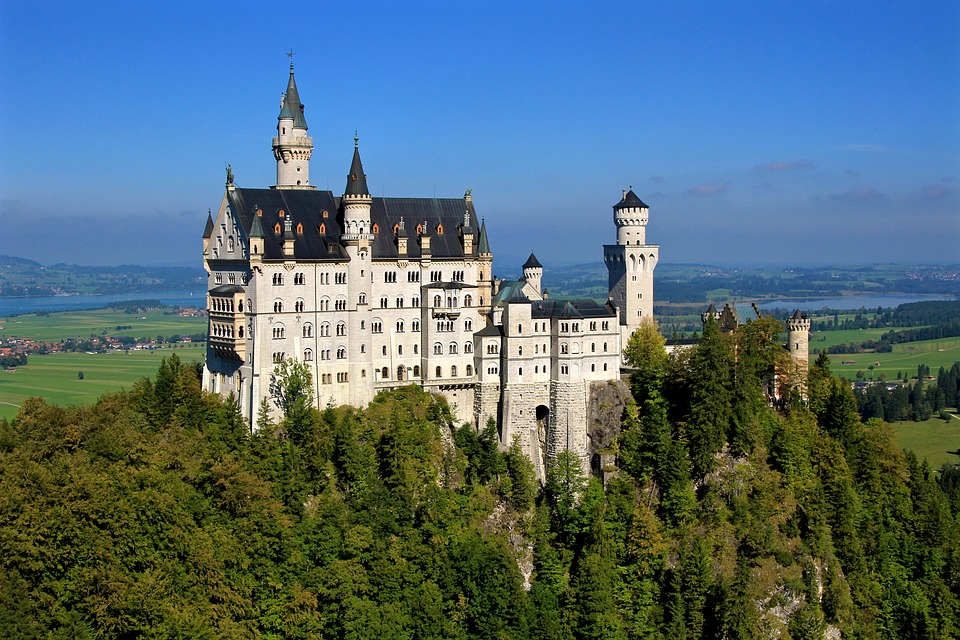Schloss Neuschwanstein Posted by Sandra Rösner on Jul 19, 2011 in Culture
It is very probable that most people have seen an imitation of the fairy-tale castle Schloss Neuschwanstein, which was, for example, the inspiration for Disneyland’s Sleeping Beauty Castle.
The original Schloss Neuschwanstein is to be found in the south of Bavaria, in the village of Hohenschwangau near the town Füssen. The castle is an idealized vision of a Ritterburg (knight’s castle) by King Ludwig II of Bavaria and by the by, it is the most popular castle of Ludwig II. It was dedicated to the life and work of the German composer Richard Wagner who actually never visited the castle.

The construction works began in 1869 and have never been really completed. Although, the Palas (great hall) and the Torhaus (gate house) had only been finished by 1886, Ludwig II could already move in two years beforehand, in 1884. Until his death in 1886 – the same year the exterior constructions of the great hall and the gate house had been completed – the King lived only for 172 days in the castle, which still resembled a Großbaustelle (large construction site) by then.
The large construction site of Neuschwanstein Castle was the major employer of the region for about two decades. Between 200 and 300 workers were working day and night on the castle. In the course oft this, a novel social institution was founded, which guaranteed wage continuation, in case that construction worker were taken ill or hurt.
As I have already mentioned, the entire complex has never been completed. Nowadays, Neuschwanstein Castle could have about 200 rooms, but only about 15 rooms and halls were expanded. The reason for this is that the realization of the building project was very expensive, which caused that Entwürfe (architect’s plans) and Kostenvoranschläge (quotations) had to be reviewed over and over again. So, because of lacking money most of the rooms could not have been completed.
The architecture and interior fittings are characterized by Romantic Eclecticism of the 19th century. The word eclecticism is derived from the Greek word eklektos, which means: chosen or elected and it is a European art style from the beginning of the Historismus (historicism) in the 19th century. That is to say, different art styles were used for the architecture by falling back on older styles and to imitate them. Neuschwanstein Castle shows the style of Romanticism (simple geometric figures like ashlars and round arches) and Gothic (aiming high lines, slim towers and filigree architectural decoration).
The castle was intended to be a private haven for Ludwig II who never proposed to make it accessible to the public. But since his death over 60 million people have visited the castle, with about more than 1 million visitors annually.
If you ever have the chance to visit the castle it is advisable to order tickets previous to your excursion. If you don’t do that it could be that you will have to wait for several hours in order to get access to Neuschwanstein. The tickets cost between 8 and 12 Euros. Children under 18 get access for free. If you are planning a trip to Bavaria here is a website where you can get some information.

Build vocabulary, practice pronunciation, and more with Transparent Language Online. Available anytime, anywhere, on any device.
About the Author: Sandra Rösner
Hello everybody! I studied English and American Studies, Communication Science, and Political Science at the University of Greifswald. Since I have been learning English as a second language myself for almost 20 years now I know how difficult it is to learn a language other than your native one. Thus, I am always willing to keep my explanations about German grammar comprehensible and short. Further, I am inclined to encourage you to speak German in every situation. Regards, Sandra




Comments:
Hichem:
Hello colleague, this is Hichem, from the “neighboring” French Blog 🙂
I enjoy reading The German Blog from times to times. I find it increasingly helpful after I moved (very recently) from the United States to Vienna, Austria.
Of course, the Austrian “flavor” of German is rather challenging, but that’s another topic… (Maybe an upcoming post?)
It’s great to read about the Schloss Neuschwanstein castle, especially that, by an interesting coincidence (or is it?) I just happened to mention the Sleeping Beauty “château” in a recent post, about this year’s “Paris Plage” Summer event and the sandcastle that Disneyland Paris built by the Seine River for the occasion.
In fact, I was there just this afternoon, and it’s rather impressive!
Maybe I’ll post a few pictures I took of it and provide a for both the French and the German Blog.
By the way, do you happen to live close to (or in) the castle? 🙂
And do you speak French “un petit peu”?
Best Greetings
Hichem:
Here’s the link to the post in question:
“Paris-Plages 2011 Begins: When The Beach Comes to Paris!” (https://blogs.transparent.com/french/paris-plages-2011-begins-when-the-beach-comes-to-paris/)